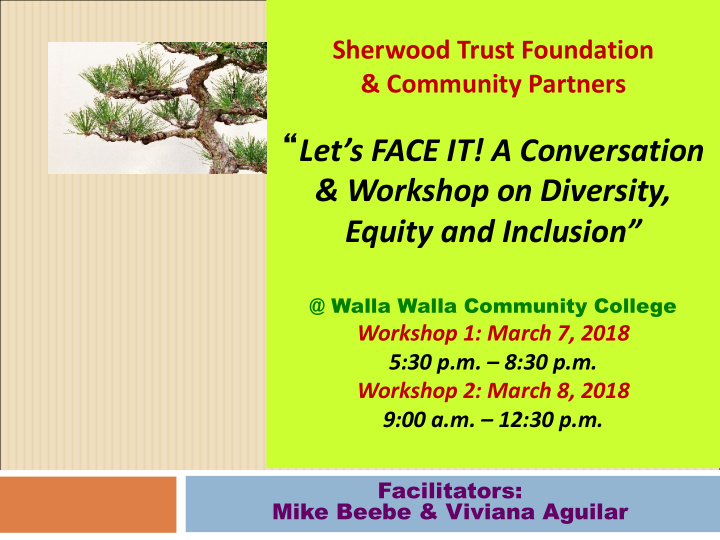



Sherwood Trust Foundation & Community Partners � Let’s FACE IT! A Conversation & Workshop on Diversity, Equity and Inclusion” @ Walla Walla Community College Workshop 1: March 7, 2018 5:30 p.m. – 8:30 p.m. Workshop 2: March 8, 2018 9:00 a.m. – 12:30 p.m. Facilitators: Mike Beebe & Viviana Aguilar
Welcome! Howdy! ¡ Bienvenidos! ¡ Bienvenidas! Glad you’re here! !Bienvenue! Foon Ying! Aloha! Willkommen!
Acknowledgements: Original keepers of this ¨ land Walla Walla Community ¨ College Lydia Caudill & the ¨ Sherwood Trust Foundation
F . = Facilitating A. = Awareness & C. = Change for E. = Equity Consulting Collaborative
Learning Outcomes: v Grow our self awareness. v Create shared language and definitions. v Aspire to be more effective ALLIES.
¨ SAFETY ¨ MUTUAL RESPECT ¨ OPEN DIALOGUE EMPLOY AN APPROACH THAT ¨ TRUST BUILDING LAYS A ¨ MAKING ‘NEW FOUNDATION CONNECTIONS’ FOR: ¨ CHALLENGING ASSUMPTIONS ¨ ADDRESSING EQUITY ¨ TAKING NEEDED ACTION
Workshop Agenda: Workshop Flow: ¤ Welcome, intros, overview ¤ “Sharing Our Names” ¤ Shared language: Diversity, Equity, Inclusion ¤ Our Cultural identities ¤ “Hot buttons” & Microaggressions ¤ Shared language: Stereotype, Prejudice, Discrimination, Oppression ¤ What are Aspiring Allies ¤ Ally Behaviors: Interrupting Microaggressions ¤ Appreciations & Closing 7
¨ Share the talk time ¨ Respect & honor each other Proposed ¨ Do active listening WORKING AGREEMENTS: ¨ Share your knowledge ¨ Technology for break time please ¨ Help one another ¨ Get curious together ¨ Move up, move back ¨ Hold space for each other that is safe and ** brave ¨ Keep confidentiality 8
Levels of the Work Structural – institutional accountability Institutional - recognize and challenge power imbalances Individual –lifelong learning & critical self reflection
Relationship Building Activity: “SHARING OUR NAMES” ¤ History, traditions, rituals? ¤ Meaning? ¤ Treatment and variation? ¤ Experiences, feelings, thoughts? ¤ Preferences? 11
WHAT IS CULTURE? “Culture is the shared set of assumptions, values, and beliefs of a group of people by which they organize their common life.” Gary Wederspahn 12
Culture is Cultural competency & beyond much like water for fish … Other metaphors?
14
Question: Who are you, culturally? How do you identify?
Significant dimensions of our cultural identities RACE/ETHNICITY GENDER GENERATION/AGE GEOGRAPHIC LOCATION NATIONALITY BODY SIZE LANGUAGE OF ORIGIN MARITAL STATUS SEXUAL ORIENTATION RELIGION/SPIRITUALITY EDUCATION FAMILY STATUS IMMIGRATION STATUS PHYSICAL/ MENTAL ABILITY ECONOMIC CLASS WORK/LABOR BIOLOGICAL SEX
Cultural Identity Sharing: ¤ Think of 4 key aspects; choose 4 pipe cleaners ¤ Reflect on how these aspects of your identity help define/inform who you are ¤ Make pipe cleaner sculpture that helps tell your story ¤ Share your story – 3-4 minutes 17
Cultural identity Questions: Who in our communities are continually asked/forced to give up parts of their identities? What is the impact of this? ¨ On individuals & families? ¨ On communities? ¨ On the broader society?
“How microaggressions are like mosquito bites – Same Difference” q Fusion Comedy video (1:58 min) q CLICK HERE
MICROAGGRESSIONS Racial Context: Racism in U.S. • “Microaggression” coined by Chester Pierce in 1970 in his work with Black Americans as “subtle, stunning, often automatic, and nonverbal exchanges which are ‘put downs’” • “…one must not look for the gross and obvious. The subtle, cumulative miniassault is the substance of today’s racism” (Pierce, 1974, p. 516) • “In and of itself a microaggression may seem harmless, but the cumulative burden of a lifetime of microaggressions can theoretically contribute to diminished mortality, augmented morbidity, and flattened confidence” (Pierce, 1995, p. 281)
Microaggressions: Definition “Brief and commonplace daily verbal, behavioral, and environmental indignities, whether intentional or unintentional, that communicate hostile, derogatory, or negative racial, gender, sexual-orientation, and religious slights and insults to the target person or group” (Derald Sue, 2010)
MICROAGGRESSIONS Characteristics • Constantly and continuously experienced • Often committed unknowingly by well- intentioned people • dismissed as innocent or innocuous • gaps between our lived experiences • Micro level manifestations of enduring institutional and systemic imbalances of privilege and power
Interrupting Do’s & Don’ts Don’t… • Roll your eyes, cross your arms • Pretend you didn’t hear/see it • Say nothing • Change the subject • Yell, curse and berate the person • Break off all ties with the person • Put yourself at risk
Interrupting Do’s & Don’ts DO! ü GET CURIOUS ü NAME IT! ü MAKE A REQUEST
ASPIRING ALLY An aspiring ally is a member of the privileged or agent group who takes a stand against social injustice directed at targeted groups or group members. An aspiring ally works to be an agent of social change rather than an agent of oppression or a passive member of society.
Ally Behavior: Interrupting Microaggressions Pair & Share: 1. Share what you WANT to say 2. Share what you MIGHT ASK or SAY to educate/interrupt and stay in dialogue
ALLY B.R.A.V.E. MODEL B uilds and brokers relationships R elates and shares information A dvocates for justice and fairness V alidates experiences, and E xplains norms (Nakashima & Hickman, 1995)
Thanks for sharing!! Xie Xie Asante MAHALO! Danke! Salamat po! ¡ Gracias ! Grazie Merci! Arigato! Toda Shukran ¡Buena suerte !
Recommend
More recommend